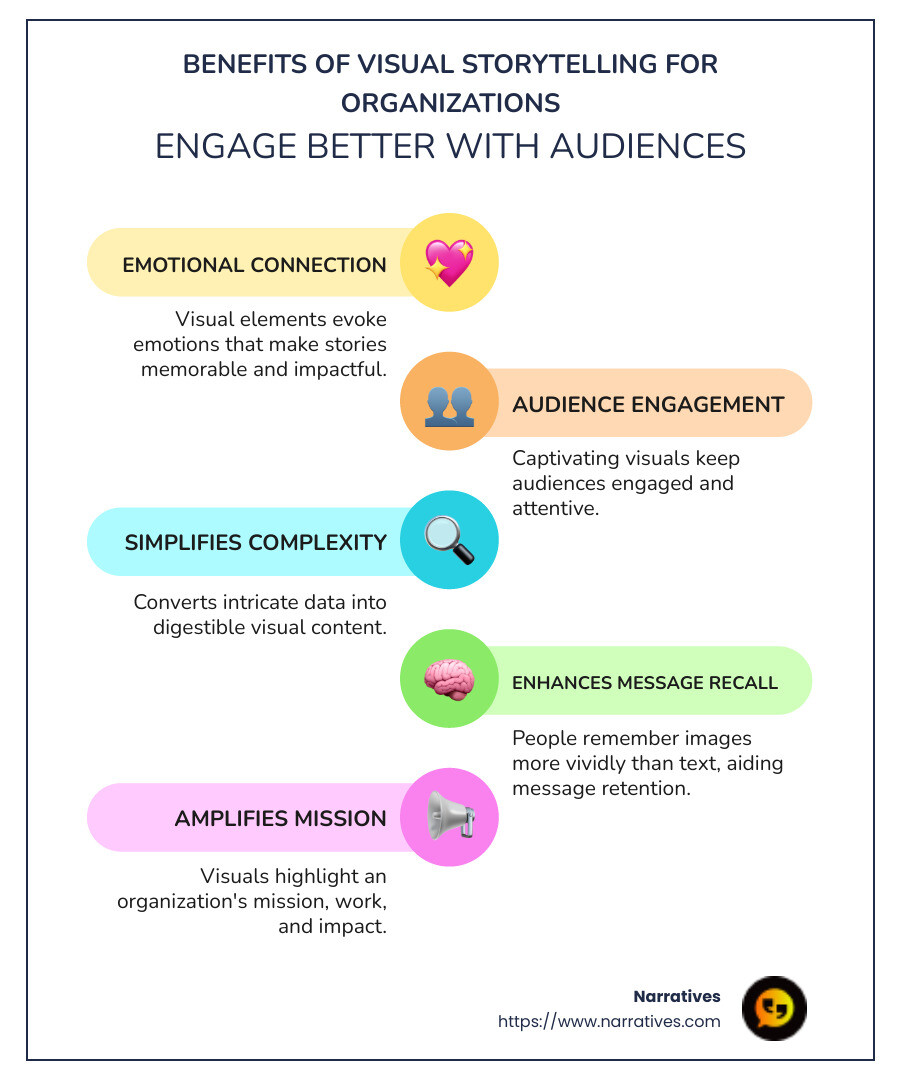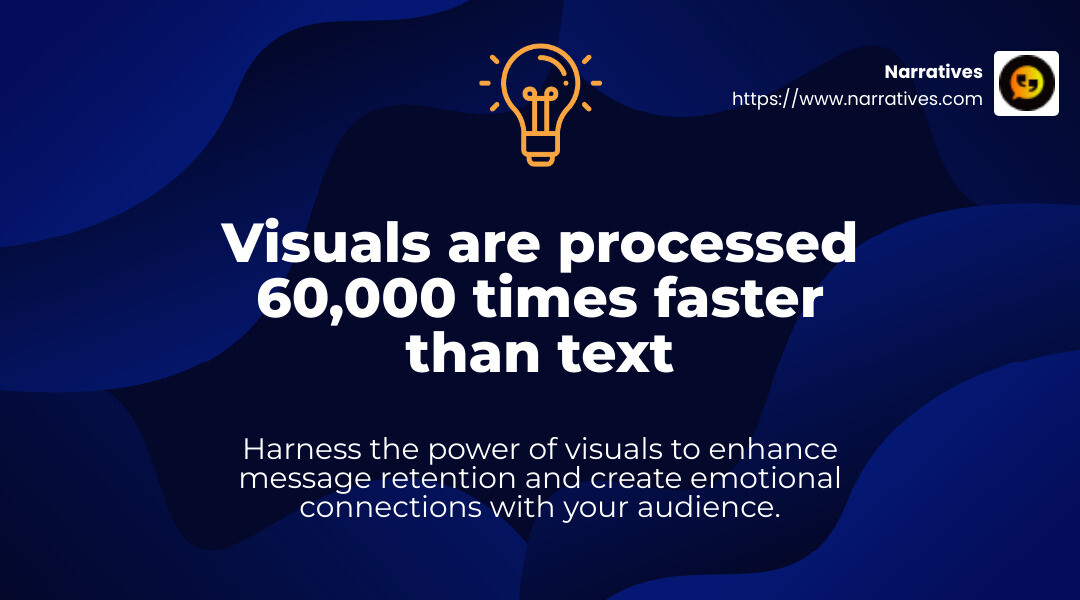Seeing is Believing: How to Implement Visual Storytelling in Your Organization

Visual storytelling for organizations is a powerful strategy that blends imagery and narrative to forge emotional connections and engage audiences. In today's digital environment, capturing attention is more challenging than ever. Organizations must create compelling, visual narratives that not only inform but also move and inspire action. This approach is especially crucial for non-profit organizations and social impact groups, where the ability to resonate emotionally with supporters can drive meaningful community engagement and support.
- Emotional Connection: Visual elements have the unique capacity to evoke emotions, making the story memorable and impactful.
- Audience Engagement: By using captivating images and narratives, organizations can better engage and retain their audience's attention.
- Simplifies Complex Information: Visuals help break down intricate concepts into easily digestible content, ensuring clear communication.
- Improves Message Recall: People often remember images more vividly than text, enhancing the overall retention of the message.
Visual storytelling is not just nice to have; it’s a necessity for organizations aiming to amplify their mission, engage their audience, and inspire change. By strategically implementing visual elements, groups can highlight their work, mission, and impact in ways that words alone cannot fully achieve.

The Importance of Visual Storytelling for Organizations
Visual storytelling is more than just a buzzword; it's a vital tool for organizations looking to create deep emotional bonds and improve audience engagement. In a world overflowing with information, visuals cut through the noise, making your message memorable and impactful.
Emotional Bonds
Visual storytelling taps into the power of emotion. A well-crafted image or video can evoke feelings that text alone often cannot. Visuals are processed 60,000 times faster in the brain than text.  This rapid processing means images can quickly connect with viewers on an emotional level, making them more likely to remember your message.
This rapid processing means images can quickly connect with viewers on an emotional level, making them more likely to remember your message.
For example, Children’s Healthcare of Atlanta uses video storytelling on their YouTube channel to share patient stories, like Samerah's journey with acute liver failure. These narratives not only inform but also create a strong emotional connection with viewers, encouraging them to support the cause.
Audience Engagement
Engagement is key in today's digital landscape. Visual storytelling keeps people on the page longer and reduces bounce rates. Infographics, for instance, are shared three times more than other content types, proving their effectiveness in engaging audiences.
Organizations can use interactive multimedia formats—like videos, charts, and infographics—to make their stories more dynamic and engaging. This approach not only grabs attention but also encourages viewers to interact with the content, deepening their connection to the message.
Simplifying Complexity
Complex information can be daunting, but visuals simplify it. They transform intricate data into easy-to-understand stories. For instance, an infographic can break down complex statistics into a clear, visual narrative, making it accessible to a wider audience.
Enhancing Message Recall
People remember images more vividly than text. By using visuals strategically, organizations can improve message recall, ensuring their stories stick in the minds of their audience. This increased retention means that your message continues to resonate long after the initial interaction.
In summary, visual storytelling for organizations is not just effective—it's essential. It builds emotional connections, boosts engagement, simplifies complex information, and improves message recall. By integrating visual storytelling into their strategies, organizations can powerfully communicate their missions and inspire action.
Key Elements of Effective Visual Storytelling
Visual storytelling isn't just about pretty pictures. It's about crafting a narrative that resonates with your audience and drives them to action. Let's break down the key elements that make visual storytelling effective for organizations.
Compelling Protagonists
Every good story needs a hero. In visual storytelling, these are the real people impacted by your work. Featuring compelling protagonists helps put a face to your cause and makes your story relatable.
Consider the example of Children’s Healthcare of Atlanta, which shares patient stories on their YouTube channel. By highlighting real experiences, they create a powerful connection with their audience. Always get permission before using someone's story or image.
Interactive Multimedia
Static images are great, but interactive multimedia takes engagement to the next level. Think videos, interactive infographics, and timelines. These formats invite your audience to engage with the content, making the story more memorable.
For instance, NBC News used scrollytelling maps and data visualizations to tackle complex topics like historical segregation in Detroit. This approach not only informs but also actively involves the viewer in the story.
Uniform Branding
Consistency is key. Your visual storytelling should align with your organization's overall brand identity. Use your logo, colors, and fonts consistently to create a cohesive narrative.
Uniform branding makes your message more impactful. It reinforces your identity and helps your audience quickly recognize your organization. This alignment is crucial for building trust and recognition over time.
Platform-Specific Adjustments
Not all platforms are created equal. Each has its own requirements and best practices. Adjust your visual content to fit the platform you're using, whether it's social media, email, or your website.
For example, social media platforms have different image size recommendations. Ensuring your visuals are optimized for each platform prevents pixelation and distortion, maintaining a professional appearance.
Mobile-Friendliness
With over half of nonprofit website traffic coming from mobile devices, mobile-friendliness is non-negotiable. Your visual content must look good and function well on smaller screens.
By coupling mobile-friendly visuals with simple mobile giving options, organizations can maximize their reach and impact. This is especially important for nonprofits aiming to engage donors and supporters on the go.
Incorporating these elements into your visual storytelling strategy can transform how your organization connects with its audience. By focusing on compelling protagonists, interactive multimedia, uniform branding, platform-specific adjustments, and mobile-friendliness, you can craft stories that not only inform but inspire action.
Visual Storytelling Techniques for Nonprofits
Visual storytelling for organizations is a powerful way to connect with audiences, especially for nonprofits. These techniques help convey complex messages in simple, engaging ways. Let's explore some effective methods.
Video Storytelling
Video is one of the most compelling forms of visual storytelling. It combines visuals, sound, and narratives to create emotional connections. Nonprofits like Children’s Healthcare of Atlanta use videos to share patient stories on YouTube. This approach personalizes their mission, making it relatable and memorable. Videos can showcase the real impact of your work, encouraging viewers to support your cause.
Interactive Maps
Maps are excellent for conveying geographic data and illustrating the scope of an organization's work. Interactive maps engage users by allowing them to explore information at their own pace. For example, NBC News used interactive maps to highlight historical segregation in Detroit, making complex data accessible and engaging. Nonprofits can use similar techniques to show where and how they operate, providing transparency and clarity to supporters.
Infographics
Infographics simplify complex information into easy-to-understand visuals. They are perfect for breaking down statistics, processes, or timelines. Infographics can improve comprehension and retention, making them valuable tools for nonprofits. By combining text, images, and data visualizations, they can effectively communicate key messages and outcomes. This approach helps audiences grasp the significance of your work quickly.
Visual Timelines
Visual timelines provide a chronological narrative of events, achievements, or milestones. They are useful for showing the history and progress of a nonprofit's initiatives. By laying out events in a visual sequence, timelines help audiences understand the journey and impact of your organization. This technique can highlight growth, challenges, and successes, motivating supporters to stay engaged and contribute to future goals.
Incorporating these visual storytelling techniques into your nonprofit's strategy can improve engagement and emotional connection with your audience. By using video storytelling, interactive maps, infographics, and visual timelines, you can effectively communicate your mission and inspire action.
How to Implement Visual Storytelling in Your Organization
Implementing visual storytelling for organizations involves changing complex data into engaging and understandable narratives. Let's discuss how to achieve this through data visualization, simplifying complexity, and turning numbers into narratives.
Data Visualization
Data visualization is a key component of visual storytelling. It involves presenting data in graphical formats like charts, graphs, or infographics. This makes it easier for audiences to understand and retain information.
For example, Charity: Water uses an interactive map to display their global water projects. Users can click on each location to learn more about the project's impact. This visual approach helps audiences grasp the scale and importance of the organization's work.
Simplifying Complexity
Complex information can overwhelm audiences. Simplifying complexity means breaking down intricate details into straightforward visuals.
At Narratives, we specialize in creating visuals that simplify complex subjects. For instance, we might use a 3D illustration to depict how urban heat can be reduced with greenery. This method helps audiences quickly understand complex solutions without wading through dense text.
Turning Numbers into Narratives
Numbers alone can be dry and unengaging. Turning numbers into narratives involves using visuals to tell a story with data.
For example, No Kid Hungry uses infographics to highlight the importance of breakfast for children. By presenting statistics visually, they make the data compelling and relatable. This approach helps audiences see the real-world impact of the numbers and motivates them to take action.
By focusing on data visualization, simplifying complexity, and turning numbers into narratives, organizations can effectively implement visual storytelling. This not only makes information more accessible but also improves engagement and emotional connection with audiences.
Frequently Asked Questions about Visual Storytelling for Organizations
What is visual storytelling?
Visual storytelling is the art of using images, videos, and other visual media to convey a narrative. It combines communication and visual media to engage audiences more effectively than text alone. By using visuals, organizations can create stories that are not only engaging but also easy to understand and remember.
How can visual storytelling benefit nonprofits?
For nonprofits, visual storytelling is a powerful tool to build emotional connections with donors and supporters. By showcasing real stories through visuals, nonprofits can highlight their mission's impact in a compelling way. This emotional engagement is crucial for donor engagement and retention.
For example, Children's Healthcare of Atlanta uses video storytelling to share patient stories. These videos not only inform but also connect with viewers on a personal level, encouraging them to support the cause.
What are some examples of visual storytelling techniques?
There are several techniques organizations can use to improve their storytelling:
Video: Videos are a dynamic way to tell a story. They can capture emotions and details that static images might miss. Nonprofits often use videos to showcase personal stories or highlight the impact of their work.
Infographics: Infographics simplify complex information into easy-to-digest visuals. They are perfect for presenting data or statistics in a way that is both informative and engaging. For instance, infographics can be used to illustrate the success of a fundraising campaign or the reach of a nonprofit's programs.
Interactive maps: These maps allow users to explore data visually. For example, an interactive map could show the locations of various projects a nonprofit is involved in, allowing users to dive deeper into each project's details. This technique not only informs but also engages users by making them part of the exploration process.
By leveraging these techniques, organizations can lift their storytelling, making it more engaging and impactful for their audience.
Conclusion
Visual storytelling is more than just a trend—it's a necessity for organizations aiming to make a meaningful impact. At Narratives, we believe in the power of digital storytelling to lift underrepresented voices and amplify the missions of nonprofits. By partnering with these organizations, we help them craft stories that are not only seen but felt.
Our approach is simple yet profound. We focus on creating emotionally resonant multimedia content that builds trust and inspires action. This is crucial for nonprofits, as emotional connections drive donor engagement and long-term support. Through our partnerships, we aim to showcase the true impact of their missions, making their stories accessible and compelling to a broader audience.
By embracing visual storytelling, nonprofits can transform their narratives into powerful tools for change. Whether through videos, infographics, or interactive maps, these stories become a bridge between the organization and its supporters. They create a shared understanding of the mission, fostering a community of engaged and passionate advocates.
Narratives is committed to being the go-to digital storytelling partner for nonprofits and purpose-driven organizations. We invite you to learn more about how we can help you share your impact stories and make a difference.
In the end, seeing is believing. And through visual storytelling, organizations can ensure their stories are not only seen but believed and acted upon.


